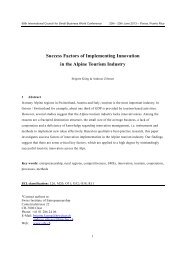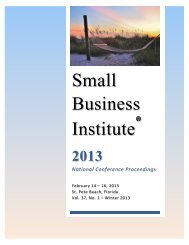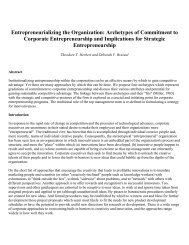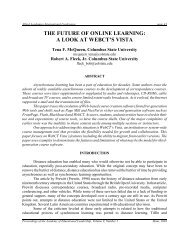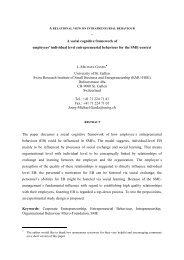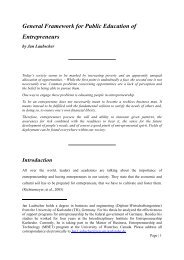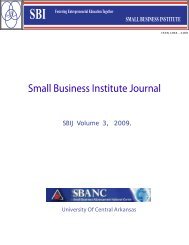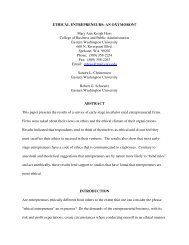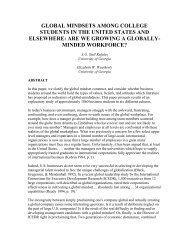selling behaviors and sales performance: soco and adapts
selling behaviors and sales performance: soco and adapts
selling behaviors and sales performance: soco and adapts
You also want an ePaper? Increase the reach of your titles
YUMPU automatically turns print PDFs into web optimized ePapers that Google loves.
97sma203<br />
SELLING BEHAVIORS AND SALES PERFORMANCE:<br />
SOCO AND ADAPTS<br />
Subhra Chakrabarty, Grambling State University<br />
Gene Brown, Louisiana Tech University<br />
Robert Widing II, University of Melbourne<br />
Craig Conrad, Wingate University<br />
ABSTRACT<br />
The relationship between <strong>selling</strong> <strong>behaviors</strong> <strong>and</strong> <strong>sales</strong> <strong>performance</strong><br />
was examined. Two measures of <strong>selling</strong> <strong>behaviors</strong>, SOCO <strong>and</strong> ADAPTS<br />
were found to be significantly related to <strong>sales</strong> <strong>performance</strong>. As<br />
the <strong>sales</strong> management literature predicts, highly customer<br />
oriented <strong>sales</strong>persons, <strong>and</strong> <strong>sales</strong>persons who adapt their <strong>sales</strong><br />
presentation to the <strong>selling</strong> situation tend to be better<br />
performers. The managerial implications are discussed.<br />
INTRODUCTION<br />
The relationship between <strong>selling</strong> <strong>behaviors</strong> <strong>and</strong> <strong>sales</strong> <strong>performance</strong><br />
continues to be a widely studied research area in marketing.<br />
According to Churchill et al. (1985, p. 116), "a <strong>sales</strong>person's<br />
efforts or <strong>behaviors</strong> are much more controllable than the results<br />
produced by those efforts." Several measures of <strong>selling</strong><br />
<strong>behaviors</strong> have been developed <strong>and</strong> tested. For example, Saxe <strong>and</strong><br />
Weitz (1982) developed the SOCO scale to measure the degree to<br />
which <strong>sales</strong>persons practice customer oriented <strong>selling</strong> <strong>behaviors</strong>.<br />
Spiro <strong>and</strong> Weitz (1990) developed the ADAPTS scale to measure the<br />
degree to which <strong>sales</strong>persons can alter their <strong>selling</strong> <strong>behaviors</strong><br />
based on perceived information about the nature of the <strong>selling</strong><br />
situation. The relationship between these measures of <strong>selling</strong><br />
<strong>behaviors</strong> <strong>and</strong> <strong>sales</strong> <strong>performance</strong> should be of interest to <strong>sales</strong><br />
managers.<br />
PURPOSE<br />
The purpose of this study is to examine the relationship between<br />
<strong>selling</strong> <strong>behaviors</strong> <strong>and</strong> <strong>sales</strong> <strong>performance</strong>. The degree to which<br />
<strong>sales</strong>persons engage in customer oriented <strong>selling</strong> <strong>behaviors</strong>, as<br />
well as, the degree to which they can adapt their <strong>sales</strong><br />
presentations to the <strong>selling</strong> situation, are likely to affect<br />
their <strong>sales</strong> <strong>performance</strong> in the long run.<br />
BACKGROUND<br />
Saxe <strong>and</strong> Weitz (1982) developed the SOCO scale as measure of the<br />
extent to which <strong>sales</strong>persons practice the marketing concept.<br />
According to Saxe <strong>and</strong> Weitz (1982, p. 344), "customer-oriented<br />
<strong>selling</strong> is a way of doing business on the part of <strong>sales</strong>people.<br />
Page 1
97sma203<br />
The term refers to the degree to which <strong>sales</strong>people practice the<br />
marketing concept by trying to help customers make purchase<br />
decisions that will satisfy customer needs. Highly customeroriented<br />
<strong>sales</strong>people engage in <strong>behaviors</strong> aimed at increasing<br />
long-term customer satisfaction. In addition, they avoid<br />
<strong>behaviors</strong> which might result in customer dissatisfaction. Thus<br />
highly customer-oriented <strong>sales</strong>people avoid actions which<br />
sacrifice customer interest to increase the probability of an<br />
immediate sale."<br />
The SOCO scale has been used as a measure of customer orientation<br />
of <strong>sales</strong>persons in a variety of contexts, such as, industrial<br />
buying (Michaels <strong>and</strong> Day 1985; O'Hara, Boles, <strong>and</strong> Johnston 1991),<br />
industrial <strong>selling</strong> (Siguaw, Brown, <strong>and</strong> Widing 1994), real estate<br />
(Dunlap, Dotson, <strong>and</strong> Chambers 1988), <strong>and</strong> retailing (Brown,<br />
Widing, <strong>and</strong> Coulter 1991).<br />
Spiro <strong>and</strong> Weitz (1990) developed the ADAPTS scale to measure the<br />
degree to which <strong>sales</strong>persons practice adaptive <strong>selling</strong> <strong>behaviors</strong>.<br />
According to Weitz, Sujan, <strong>and</strong> Sujan (1986, p 175), "the practice<br />
of adaptive <strong>selling</strong> is defined as the altering of <strong>sales</strong> <strong>behaviors</strong><br />
during a customer interaction or across customer interactions<br />
based on the perceived information about the nature of the<br />
<strong>selling</strong> situation."<br />
The ADAPTS scale has also been used in past studies. For<br />
example, Levy <strong>and</strong> Sharma (1994) used the scale to measure the<br />
degree to which retail <strong>sales</strong>persons engage in adaptive <strong>selling</strong><br />
<strong>behaviors</strong>. Spiro <strong>and</strong> Weitz (1990) found significant positive<br />
relationship between ADAPTS <strong>and</strong> <strong>sales</strong>persons' self-assessment of<br />
<strong>performance</strong>.<br />
If <strong>sales</strong>persons are practicing the marketing concept by being<br />
customer oriented, <strong>and</strong> adapting their <strong>selling</strong> <strong>behaviors</strong> to the<br />
<strong>sales</strong> situations, their <strong>sales</strong> <strong>performance</strong> should improve.<br />
Consequently, the SOCO scores <strong>and</strong> the ADAPTS scores of<br />
<strong>sales</strong>persons should be positively related to <strong>sales</strong> <strong>performance</strong>.<br />
Measurement of Constructs<br />
METHODOLOGY<br />
The constructs of this study were measured on multiple-item<br />
scales, mostly drawn from past studies. Table 1 presents the<br />
summary statistics of the study variables. The customer<br />
orientation of <strong>sales</strong>persons was measured using the 24 item SOCO<br />
scale (Saxe <strong>and</strong> Weitz 1982). The endpoints of the scale ranged<br />
from 1 (true for none of your customers) to 9 (true for all of<br />
your customers). The adaptive <strong>selling</strong> behavior of <strong>sales</strong>persons<br />
was measured using the 16 item ADAPTS scale (Spiro <strong>and</strong> Weitz<br />
Page 2
97sma203<br />
1990). The endpoints of the scale ranged from 1 (very strongly<br />
disagree) to 9 (very strongly agree).<br />
Table 1<br />
Means, St<strong>and</strong>ard Deviations, <strong>and</strong> Coefficient Alpha<br />
No. of<br />
Mean Std. Dev. Scale Items Alpha<br />
-----------------------------------------------------------------<br />
Customer Orientation 6.09 1.00 24 0.81<br />
Adaptive Selling 6.15 1.00 16 0.75<br />
Sales Performance 4.12 0.77 1 na*<br />
Sales Performance 6.71 1.28 31 0.96<br />
*not applicable<br />
-----------------------------------------------------------------<br />
Salesperson <strong>performance</strong> was measured using the 31 item scale<br />
developed by Behrman <strong>and</strong> Perreault (1982). The endpoints of the<br />
scale ranged from 1 (your <strong>performance</strong> is very low compared to an<br />
average <strong>sales</strong>person) to 9 (your <strong>performance</strong> is very high compared<br />
to an average <strong>sales</strong>person). In addition, each <strong>sales</strong>person<br />
responded to a 5-point scale anchored by 1 (my <strong>performance</strong> is<br />
near the bottom) <strong>and</strong> 5 (my <strong>performance</strong> is near the top). The<br />
items were similar to Spiro <strong>and</strong> Weitz (1990). Thus, we had two<br />
self-report measures of <strong>sales</strong> <strong>performance</strong>. The SOCO, ADAPTS, <strong>and</strong><br />
<strong>sales</strong> <strong>performance</strong> scores for each respondent were derived by<br />
summating the items of the corresponding scales.<br />
As Table 1 indicates, the measures were reliable. The<br />
respondents of this study were moderately customer oriented,<br />
since the mean SOCO score is 6.09 on a 9 point scale. They were<br />
not highly adaptive to their customers given that the mean ADAPTS<br />
score is 6.15 on a 9 point scale. The mean <strong>performance</strong> score was<br />
6.71 on a 9 point scale. Thus, the respondents of the current<br />
study rated themselves as slightly higher than an average<br />
<strong>sales</strong>person. The single item measure of <strong>sales</strong> <strong>performance</strong><br />
indicates that the respondents believed that their <strong>performance</strong><br />
was above average.<br />
Sample And Data Collection Procedures<br />
The variables in the current study were measured from the<br />
<strong>sales</strong>person's perspective using a self-report mail questionnaire.<br />
The sampling frame consisted of the missionary <strong>sales</strong>persons of a<br />
pharmaceutical manufacturer in India. Questionnaires were<br />
Page 3
97sma203<br />
distributed to the 253 <strong>sales</strong>persons who cover the major markets<br />
in India. Financial constraints allowed only a single mailing.<br />
The original distribution of 253 questionnaires yielded 146<br />
responses. After accounting for missing data, a total of 138<br />
usable responses was obtained, thereby providing a response rate<br />
of 54.5%. Nonresponse bias was assessed by comparing early with<br />
late respondents as suggested by Armstrong <strong>and</strong> Overton (1977).<br />
No significant differences were found on the study variables.<br />
Therefore, nonresponse bias does not appear to be a significant<br />
issue in the current study.<br />
Regarding subject characteristics, 7.7% of the respondents were<br />
female <strong>and</strong> 92.3% of the respondents were male. 80% of the<br />
respondents were college graduates, indicating that the<br />
<strong>sales</strong>persons were highly educated. The average age of the<br />
respondents was 28.5 years, <strong>and</strong> their average <strong>selling</strong> experience<br />
was 6.2 years. Consequently, the subjects were young <strong>and</strong><br />
relatively less experienced.<br />
ANALYSIS AND RESULTS<br />
The results are divided into two sections. The first section<br />
describes the statistical properties of the variables of this<br />
study compared to past applications. The second section<br />
discusses the relationship between <strong>selling</strong> <strong>behaviors</strong> <strong>and</strong> <strong>sales</strong><br />
<strong>performance</strong>.<br />
The SOCO Scale<br />
The statistical properties of the SOCO scale compared to past<br />
applications are presented in Table 2. As indicated, the mean<br />
SOCO score lies above the midpoint. Consequently, the<br />
respondents of this study were customer oriented with more than<br />
half of their customers. The skewness is moderate. The scale<br />
compared well with past applications.<br />
Table 2<br />
Statistical Comparison Across Studies<br />
Siguaw Brown,<br />
Brown, Widing, Saxe/ Saxe/<br />
Current <strong>and</strong> <strong>and</strong> Weitz Weitz Michaels<br />
Study Widing Coulter Sample Sample <strong>and</strong> Day<br />
(9 pt. (9 pt. (6 pt. 1 (9 pt. 2 (9 pt. (9 pt.<br />
scale) scale) scale) scale) scale) scale)<br />
------------------------------------------------------------------<br />
N 138 306 348 191 95 997<br />
Mean 6.09 7.81 3.46 7.63 7.75 5.75<br />
Page 4
97sma203<br />
Std. Dev. 1.00 0.68 13 24 18 22<br />
Skewness -.06 nr* -.27 -1.33 -.88 -.34<br />
Coefficient<br />
Alpha 0.81 0.86 0.81 0.86 0.83 0.91<br />
*not reported<br />
------------------------------------------------------------------<br />
The ADAPTS Scale<br />
The statistical properties of the ADAPTS scale compared to past<br />
applications are presented in Table 3. As indicated, the mean<br />
ADAPTS score lies slightly above the midpoint. Consequently, the<br />
respondents of this study slightly agree that they alter their<br />
<strong>selling</strong> <strong>behaviors</strong> based on the perceived nature of the <strong>selling</strong><br />
situation. This finding is contrary to past applications in U.S.<br />
For example, Spiro <strong>and</strong> Weitz (1990) reported that the mean rating<br />
for their sample of <strong>sales</strong>persons was very high (5.51). Given<br />
that missionary <strong>selling</strong> involves repeated interactions with a set<br />
customers, it is striking that the respondents of the current<br />
study are not highly adaptive.<br />
Table 3<br />
Statistical Comparison Across Studies<br />
Current Study Levy <strong>and</strong> Sharma Spiro <strong>and</strong> Weitz<br />
(9 point scale) (7 point scale) (5 point scale)<br />
-----------------------------------------------------------------<br />
N 138 201 268<br />
Mean 6.15 5.33 5.51<br />
Std. Dev. 1.00 0.91 0.66<br />
Skewness 0.16 nr* nr*<br />
Coefficient<br />
Alpha 0.75 0.84 0.85<br />
*not reported<br />
-----------------------------------------------------------------<br />
Sales Performance<br />
The statistical properties of the <strong>sales</strong> <strong>performance</strong> measure<br />
compared to past applications are presented in Tables 4A <strong>and</strong> 4B.<br />
As Table 4A indicates, the respondents rated their <strong>performance</strong> as<br />
Page 5
97sma203<br />
slightly higher than an average performer. The mean <strong>sales</strong><br />
<strong>performance</strong> score is relatively lower than past applications.<br />
Table 4A<br />
Statistical Comparison Across Studies<br />
Behrman <strong>and</strong> Goolsby, Lagace,<br />
Current Study Perreault <strong>and</strong> Boorom<br />
(9 point scale) (7 point scale) (7 point scale)<br />
-----------------------------------------------------------------<br />
N 138 196 177<br />
Mean 6.71 5.45 3.91<br />
Std. Dev. 1.28 0.67 9.89<br />
Skewness -1.12 nr* nr*<br />
Coefficient<br />
Alpha 0.96 0.94 0.89<br />
*not reported<br />
-----------------------------------------------------------------<br />
With regard to the alternative measure of <strong>sales</strong> <strong>performance</strong>, the<br />
comparison with Spiro <strong>and</strong> Weitz (1990) is presented in Table 4B.<br />
As Table 4B indicates, the <strong>performance</strong> ratings are comparable to<br />
the 31 item measure, meaning that the respondents rated<br />
themselves slightly above average. However, the mean rating is<br />
slightly lower than that of Spiro <strong>and</strong> Weitz (1990). Overall, the<br />
<strong>sales</strong> <strong>performance</strong> measures compared well with past studies.<br />
Table 4B<br />
Statistical Comparison Across Studies<br />
Current Study Spiro <strong>and</strong> Weitz (1990)<br />
-----------------------------------------------------------------<br />
N 138 268<br />
Mean 4.12 4.41<br />
Std. Deviation 0.66 0.77<br />
Skewness -.30 nr*<br />
*not reported<br />
-----------------------------------------------------------------<br />
Selling Behaviors And Sales Performance<br />
Page 6
97sma203<br />
The relationship between <strong>selling</strong> <strong>behaviors</strong> <strong>and</strong> <strong>sales</strong> <strong>performance</strong><br />
was examined by correlating SOCO, ADAPTS, <strong>and</strong> <strong>sales</strong> <strong>performance</strong>.<br />
The correlations are reported in Table 5. As indicated, there is<br />
a significant positive correlation between <strong>selling</strong> <strong>behaviors</strong> <strong>and</strong><br />
<strong>sales</strong> <strong>performance</strong>. Thus, <strong>sales</strong>persons who engage in customer<br />
oriented <strong>selling</strong> <strong>behaviors</strong>, <strong>and</strong> who alter their <strong>sales</strong><br />
presentations according to the <strong>selling</strong> situation, are likely to<br />
improve their <strong>performance</strong>. In addition, the SOCO scores <strong>and</strong> the<br />
ADAPTS scores were themselves significantly positively<br />
correlated. Consequently, the higher the customer orientation of<br />
<strong>sales</strong>persons, the more adaptive they are to their customers.<br />
Table 5<br />
Selling Behaviors <strong>and</strong> Sales Performance<br />
Performance Performance<br />
Variables SOCO ADAPTS (31 items) (1 item)<br />
-----------------------------------------------------------------<br />
SOCO 1.00 0.52** 0.19* 0.25**<br />
ADAPTS 1.00 0.24** 0.18*<br />
Performance<br />
(31 items) 1.00 0.33**<br />
Performance<br />
(1 item) 1.00<br />
*p
97sma203<br />
LIMITATIONS<br />
In this study, <strong>performance</strong> of <strong>sales</strong>persons was measured by selfreport.<br />
The usefulness of self-generated descriptions of<br />
behavior in evaluating <strong>performance</strong> has been criticized on the<br />
grounds that individuals are lenient in self-ratings <strong>and</strong> tend to<br />
inflate self-ratings due to a self-serving bias (Murphy <strong>and</strong><br />
Clevel<strong>and</strong> 1991). However, the respondents of the current study<br />
are missionary <strong>sales</strong>persons who frequently work in teams.<br />
Behrman <strong>and</strong> Perreault (1982, p. 356) noted that "quantitative<br />
measures may be problematic when team <strong>selling</strong>, missionary<br />
<strong>selling</strong>, or long <strong>selling</strong> cycles are an issue." The <strong>sales</strong> volume<br />
achieved by these <strong>sales</strong>persons may also differ due to<br />
inequalities in territory potential. Managerial evaluations of<br />
<strong>sales</strong>person <strong>performance</strong> have also been criticized for halo<br />
effects, interpersonal bias, leniency, <strong>and</strong> the possibility of<br />
<strong>sales</strong>persons using ingratiation to bias their managers<br />
(Cocanougher <strong>and</strong> Ivancevich 1978; Heneman 1974). In addition, a<br />
meta-analysis of past studies on <strong>sales</strong>person <strong>performance</strong><br />
indicated that the method of measuring the dependent variable<br />
(<strong>sales</strong> <strong>performance</strong>) does not moderate the relationship between<br />
individual predictors <strong>and</strong> <strong>sales</strong> <strong>performance</strong> (Churchill et al.<br />
1985). However, given the possibility of upward bias in<br />
<strong>sales</strong>person self-evaluations of <strong>performance</strong>, the results of this<br />
study should be interpreted with caution.<br />
REFERENCES<br />
Armstrong, J. Scott <strong>and</strong> Terry Overton (1977), "Estimating<br />
Nonresponse Bias in Mail Surveys," Journal of Marketing Research,<br />
14 (August), 396-402.<br />
Behrman, Douglas N. <strong>and</strong> William D. Perreault, Jr. (1982),<br />
"Measuring the Performance of Industrial Salespersons," Journal<br />
of Business Research, 10 (September), 355-370.<br />
Behrman, Douglas N. <strong>and</strong> William D. Perreault, Jr. (1984), "A Role<br />
Stress Model of the Performance <strong>and</strong> Satisfaction of Industrial<br />
Salespersons," Journal of Marketing, 48 (Fall), 9-21.<br />
Brown, Gene, Robert E. Widing II, <strong>and</strong> Ronald L. Coulter (1991),<br />
"Customer Evaluation of Retail Salespeople Utilizing the SOCO<br />
Scale: A Replication, Extension, <strong>and</strong> Application," Journal of<br />
the Academy of Marketing Science 19 (Fall), 347-351.<br />
Churchill, Gilbert A., Jr., Neil M. Ford, Steven W. Hartley, <strong>and</strong><br />
Orville C. Walker, Jr. (1985), "The Determinants of Salesperson<br />
Performance: A Meta-Analysis," Journal of Marketing Research, 22<br />
(May), 103-118.<br />
Page 8
97sma203<br />
Cocanougher, A. Benton <strong>and</strong> John M. Ivancevich (1978), "BARS<br />
Performance Rating for Sales Force Research," Journal of<br />
Marketing, 42 (July), 87-95.<br />
Dunlap, B.J., M.J. Dotson, <strong>and</strong> T.M. Chambers (1988), "Perceptions<br />
of Real Estate Brokers <strong>and</strong> Buyers: A Sales- Orientation,<br />
Customer-Orientation Approach," Journal of Business Research, 17<br />
(September), 175-187.<br />
Goolsby, Jerry R., Rosemary Lagace, <strong>and</strong> Michael Boorom (1992),<br />
"Psychological Adaptiveness <strong>and</strong> Sales Performance," Journal of<br />
Personal Selling <strong>and</strong> Sales Management, 12 (Spring), 51-66.<br />
Heneman, Herbert G. (1974), "Comparisons of Self <strong>and</strong> Superior<br />
Ratings of Managerial Performance," Journal of Applied<br />
Psychology, 59, 638-642.<br />
Levy, Michael <strong>and</strong> Arun Sharma (1994), "Adaptive Selling: The<br />
Role of Gender, Age, Sales Experience, <strong>and</strong> Education," Journal of<br />
Business Research, 31, 39-47.<br />
Michaels, R.E. <strong>and</strong> Ralph L. Day (1985), "Measuring Customer<br />
Orientation of Salespeople: A Replication With Industrial<br />
Buyers," Journal of Marketing Research, 22 (November), 443-446.<br />
Murphy, Kevin R. <strong>and</strong> Jeanette N. Clevel<strong>and</strong> (1991), "Performance<br />
Appraisal: An Organizational Perspective. Needham Heights, MA:<br />
Allyn <strong>and</strong> Bacon.<br />
O'Hara, Bradley S., James S. Boles, <strong>and</strong> Mark W. Johnston (1991),<br />
"The Influence of Personal Variables on Salesperson Selling<br />
Orientation," Journal of Personal Selling & Sales Management 11<br />
(Winter), 61-67.<br />
Saxe, Robert <strong>and</strong> Barton A. Weitz (1982), "The SOCO Scale: A<br />
Measure of the Customer Orientation of Salespeople," Journal of<br />
Marketing Research, 19 (August), 343-351.<br />
Siguaw, Judy A., Gene Brown, <strong>and</strong> Robert E. Widing II (1994), "The<br />
Influence of the Market Orientation of the Firm on Sales Force<br />
Behavior <strong>and</strong> Attitudes," Journal of Marketing Research, 31<br />
(February), 106-116.<br />
Spiro, Rosann L. <strong>and</strong> Barton A. Weitz (1990), "Adaptive Selling:<br />
Conceptualization, Measurement, <strong>and</strong> Nomological Validity,"<br />
Journal of Marketing Research, 27 (February), 61-69.<br />
Weitz, Barton A., Harish Sujan, <strong>and</strong> Mita Sujan (1986),<br />
"Knowledge, Motivation <strong>and</strong> Adaptive Behavior: A Framework for<br />
Page 9
97sma203<br />
Improving Selling Effectiveness," Journal of Marketing, 50<br />
(October), 174-191.<br />
Page 10



